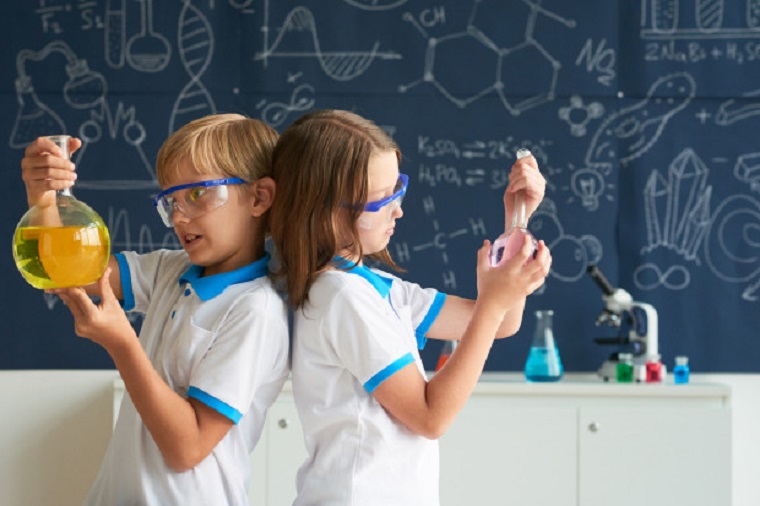INTRODUCTION
Most of the children don’t like to have a traditional teaching method. Traditional teaching methods always portray theoretical explanations where students feel bored. Moreover, by practising theoretical classes, students may lack practical exposure. Every child must have strong foundations about the subjects. So to have a strong foundation, a better way to follow is through projects. Through live projects, students can have practical knowledge. Moreover, through practical knowledge, primary class students recognize science as an interesting subject. By practising these activities for children makes exciting projects at schools and also at home, they can have practical exposure. This article explains ten exciting primary school projects for kids
1. VOLCANIC ERUPTION
One interesting project that every student loves is the Volcanic eruption. Even though it is a simple and basic project, kids get excited when they perform it in schools.
MATERIALS REQUIRED – Bicarbonate of soda, vinegar, bottle, old newspapers and cardboard, Watercolors.
PROCEDURE
- Place the bottle in the center of the cardboard and cover it with old newspapers. Showcase the newspapers in the shape of a mountain.
- Colour the newspapers with a combination of red and brown colors. Allow it to dry for a few hours
- Add three to four spoons of bicarbonate of soda inside the bottle. Then add some hot water and a few drops of food coloring. Finally, add vinegar to it.
RESULT – Now you can witness lava which is being erected from the volcano.
2. LEMON JUICE AS INVISIBLE INK
Every school child gets excited by performing the project – “Lemon Juice as an invisible ink”. This activity involves lots of fun and excitement.
MATERIALS REQUIRED – Lemon, Water, Cotton bud, Bowl, Paper.
PROCEDURE
- Place a bowl and squeeze a lemon into it. Add a few drops of water to it. Mix the substances well with the spoon.
- Take a cotton bud and dip it into the mixture. Once dipped, write a message on a plain white paper.
- Make the paper to dry so that ink gets completely invisible.
- Finally, to read the secret message, heat the paper by keeping in front of the electric bulb.
RESULT – Now you can witness the secret message. This is due to the presence of organic substances in the lemon juice. The organic substance oxidizes and turns brown when it is heated.
3. MAGIC RAINBOW JAR
Another interesting and exciting project that kids love is “Magic rainbow jar”. Through this project, you can teach about the density of liquids. To experiment with this project, you need only the basic items in your kitchen.
MATERIALS REQUIRED – Container, Food Coloring (Red, Blue & Green) Honey, Dish soap, Olive oil and Rubbing alcohol.
PROCEDURE
- Initially add red and blue food coloring into honey. By adding this, the honey color changes to purple. Place a bowl or a container and add the purple solution to it.
- Now add dish soap into the container
- Then add green food coloring into the water. By adding this, water changes to green color. Now add the green colored water into the container
- Finally, add olive oil and rubbing alcohol into the container.
RESULT – Through this experiment, kids can learn about the densities of different liquids.
4. DANCING RAISINS
Another fun-filled experiment that kids love is “Dancing Raisins”. To perform this project you need club soda or clear soda, glass and a few raisins. To start with this experiment, pour fresh and clear soda into the glass. Add a few raisins into the glass. Ask your kid whether it gets sink or floats. Wait for a minute to come up with the result.
When you drop the raisins into the soda, it settles down at the bottom because of higher density than soda. When soda releases carbon dioxide, the raisins act as a tiny floatation.
5. BLOWING BALLOON
Another exciting project to blow a balloon is very interesting and exciting for kids. To perform this activity, you need a balloon, a plain bottle, vinegar and a baking soda.
PROCEDURE
- Pour a little amount of vinegar into the plain bottle.
- Then carefully add baking soda into the balloon using the funnel.
- Checkout that the vinegar is away from baking soda before you place the balloon on the bottle’s mouth portion.
- When you move the balloon slowly in the upward direction(lift the balloon)in a way that the stored baking soda falls into the vinegar which automatically triggers the reaction.
- As a result, the balloon starts blowing when baking soda and vinegar make contact.
RESULT – When baking soda and vinegar come into contact, there emits carbon dioxide and makes the balloon blow.
6. CLOUD IN A JAR
Every kid gets excited when they make their own clouds for projects. This project definitely makes the student excited. To perform this project, you need warm water, a jar with a lid, ice cubes and aerosol hairspray.
PROCEDURE
- Pour warm water into the jar and swirl it around the whole jar
- Turn the lid upside down and place ice cubes on top. Now place the lid on the top of the jar.
- Now quickly remove the lid and make a quick spray of aerosol hairspray and replace immediately with a lid.
- Finally, remove the lid and watch the formation of clouds.
7. FIZZY LEMONADE
Another exciting project by using lemon makes the kid fun-way learning. This experiment requires simple items such as lemon, cold water, baking soda, sugar, glass and spoon.
PROCEDURE
- Take a glass and squeeze a lemon into it. Add an equal amount of cold water to it.
- Add a spoon of baking soda and stir well.
- If needed also add sugar to it.
RESULT – Generally, baking soda is alkaline in nature and lemon juice is an acid. When both make a contact, there emits carbon dioxide which is a base reaction. So you can witness bubbles in lemonade.
8. SUGAR GLASS
Another interesting example that definitely makes your kid excited is the “Sugar Glass” project. To perform this project, you need superfine sugar, corn syrup, water, cream of tartar, baking paper.
PROCEDURE
- Start this project by preparing sugar syrup. To do the sugar syrup, take equal quantities of sugar and water in the non-stick pan and start heating.
- Before reaching the sugar syrup, add other ingredients such as tartar, corn syrup and food coloring.
- Once it reaches the sugar syrup consistency, turn off the flame. Now pour the sugar syrup into the baking paper.
- In the baking paper, spread the sugar syrup. Allow it to dry
- Once it gets drained, remove the baking paper slowly from the sugar syrup
- Now you can witness a tasty sugar class.
9. BUILDING A SOLAR SYSTEM
Every kid dreams high. By teaching them about the solar system they get interested in astronomy. This project “Building a solar system” makes the student get practical knowledge. You need cardboard’s which are painted black, threads to build the orbits and 10 balls in different shapes and colors.
To start with this project, build orbits for each planet. Then stick out the balls around each orbit. Make sure that ball fits exactly with the planet’s identity. By doing this project, your kid will be able to know about the solar systems.
10. STRING TELEPHONE
A string telephonic project is another exciting thing which makes your kid fun-filled one.
MATERIALS REQUIRED – 2 Paper cups, a sharp needle and a string.
PROCEDURE
- Initially make a hole at the bottom of the paper cups.
- Cut the string for 20 meters.
- Now tie the string at the bottom of the cup
RESULT – Make the two persons stand at both corners. As one person keeps the paper cup in his ears. Ask another person to speak. This is because the cup creates sound waves and provides vibration in the string. So the person on the opposite side can hear what the other person said.
CONCLUSION
Projects provide practical knowledge about science. These projects make the student fall in love with science. Enjoying science makes the child become a scientist. They can discover more projects and experiments. Hope this article helps your child.

